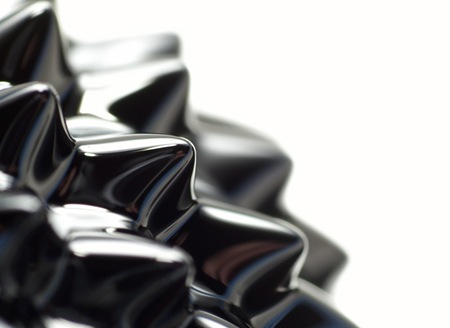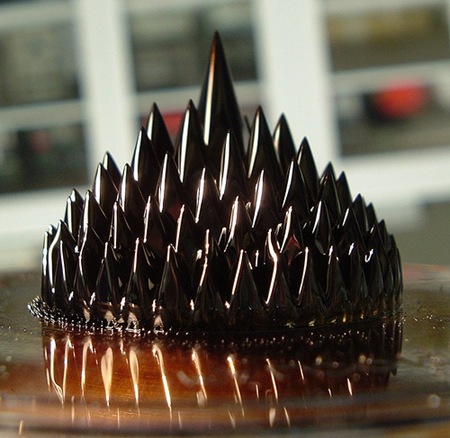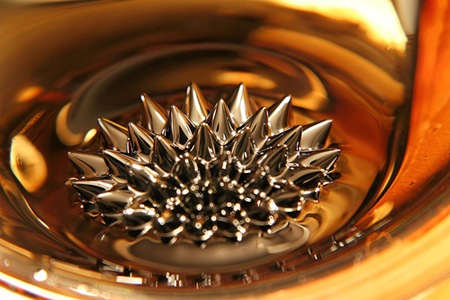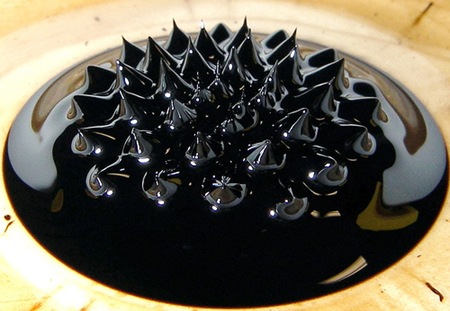1006 Morton Street
Baltimore, MD 21201
410.576.9131 | RW1haWw=
September 2 2008
FerroFluids: Physics is Beautiful
Immanuel Kant, in 1790, described beauty as 'sensory, emotional, and intellectual,' a synthesis of data which we as humans process when evaluating objects. More recently Abraham Moles, Frieder Nake and Jurgen Schmidhuber, leaders in the field of aesthetics and information theory, described beauty as 'the option with the shortest description, given the observer's previous knowledge and method for encoding data.' We as humans often find forms in nature which we find pleasing and wish to share. Whether it is a vista or microscopic, the structures nature has built are often times inherently beautiful to our eyes for probably very complex reasons alluded to by philosophers and scientists throughout the ages.
Ferrofluids are one of my favorite examples of beauty and aesthetics occurring spontaneously as a simple reaction between elements and forces of nature. A fluid, formless and simple, turns instantly into a sculpture, structural and complex with little more than the application of a magnetic field. The phenomena is used in many industrial applications including the seal on the hard drive spinning in your computer and has recently been used to create abstract art. 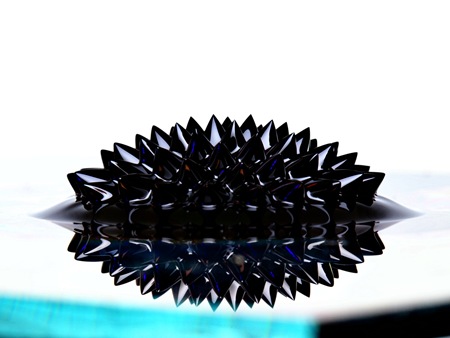
Ferrofluids are liquid mixtures of surfactant coated magnetic nanoparticles in a carrier fluid which are easily susceptible to magnetic fields. The compounds themselves contain some iron (hence ferrous, ferrum, meaning iron in latin) but the liquid mixture is not magnetic. Brownian motion applies between particles and means that the mixture does not settle under typical conditions.
The fluids react in predictable but astounding ways in the presence of even the smallest magnetic field. The only criteria is that the field be strong enough to overcome surface and gravitational forces on the fluid. This effect is called the 'normal-field instability' and results in a regular pattern of corrugations on the surface of the fluid. Amplitude and frequency depend on the strength of the magnetic field and it is important to note that the fluid returns to a completely liquid state upon the removal of the magnetic field.
Below is an example of artwork created by carefully and selectively applying a magnetic field to a ferrofluid by artists Sachiko Kodama and Yasushi Miyajima.
Recent Posts
Reimagining Harborplace to Create Space for Both Private Development and Expanded Public Space » Lawyer's Mall Reconstruction Progress » Confronting the Conventions of Customary Practice » Reconceived Facades: New Roles for Old Buildings » Ivy Bookshop Opens for Business! »
Categories
Yellow Balloon Baltimore » Products + Technology » Industry + Practice » Other » Architecture »
Links
Organizations
- USGBC Baltimore Regional Chapter »
- AIA - American Institute of Architects »
- USGBC »
- The Walters Art Museum »
- Green-e »
- Center for Building Performance and Diagnostics (CMU) »
- Green Globes »
- Prefab Lab (UT) »
- Center for Sustainable Development (UT) »
- Architecture 2030 »
- Bioneers »
- Street Films »
- FreeCycle »
- Chesapeake Bay Foundation »
- Archinect »
- BD Online - The Architects Website »
- National Wildlife Foundation »
- Natural Resources Defense Council »
- Overbrook Foundation »
- Merck Family Foundation »
- Ecology Center »
- New Building Institute »
- Neighborhood Design Center »
- The Leonardo Academy »
- ZigerSnead Architects LLP »
- The Rocky Mountain Institute »
- Urban Habitats »
- ACORE - American Council on Renewable Energy »
- Parks and People Foundation of Baltimore »
- Open Society Institute of Baltimore »
- Natural Capital Institute »
- Passive House US »
- Svanen Miljomark »
- Green Restaurant Association »
- Rocky Mountain Institute »
- Green Exhibits »
- Green Roundtable »
- John Elkington - SustainAbility »
- SustainAbility »
- Building America »
- Endangered Species Program - Fish and Wildlife Service »
- Congress for the New Urbanism »
- Urban Land Institute »
- Cool Roof Rating Council »
- Montgomery County (MD) Public Schools Green Building Program »
- National Institute of Standards and Technology Software »
- Scientific Certification Systems »
- Community Greens »
- CBECS »
- CASE - Center for Architecture Science and Ecology »
Interesting Sites
- The Ecologist »
- Treehugger »
- Grist »
- WIRED »
- Planet Architecture »
- MiljoBloggAktuellt - Environmental News Blog (Swedish »
- Sustainable Design Update »
- Eikongraphia »
- World Architecture News »
- The Cool Hunter »
- Design Center »
- ZEDfactory »
- Architen Landrell Associates Ltd. »
- Environmental Graffiti »
- businessGreen »
- Best Green Blogs Directory »
- Groovy Green »
- EcoGeek »
- Urban Ecology »
- Locus Architecture »
- Urbanite »
- A Daily Dose of Architecture »
- Adaptive Reuse »
- Audacious Ideas »
- Big Green Me »
- NOTCOT »
- Sustainable Baltimore »
- Thoughts on Global Warming »
- Green Maven »
- WorldChanging »
- Go For Change »
- Building Green »
- Home Energy Magazine »
- Home Energy Blog »
- FEMA Map Service- Federal Emergency Management Association »
- Architectural Graphic Standards »
- E-Wire »
- Post Carbon Cities »
- Alt Dot Energy »
- Whole Building Design Guide »
- B'more Green »
- EJP: Environmental Justice Partnership »
- Baltidome »
- OneOffMag »
